Measuring the Level of Environmental Performance on Coastal Environment before and during the COVID-19 Pandemic: A Case Study from Cyprus
Abstract
1. Introduction
2. Material and Methods
2.1. Area Description
2.2. Sampling Period
2.3. Key Performance Indicators (KPIs)
2.3.1. Waste Compositional Analysis
2.3.2. Clean Coast Index (CCI), Waste Accumulation Index (WAI), Level of Services (LOS), Waste Accumulation Rate (WAR)
| Quality | Level of Services | CCI | Classification |
|---|---|---|---|
| Very clean | 1 (A) | 0–2 | No waste is observed |
| Clean | 2 (B) | 2–5 | No waste is observed over a large area |
| Moderate | 3 (C) | 5–10 | A few items of waste can be observed |
| Dirty | 4 (D) | 10–20 | A lot of waste exists |
| Very dirty | 5 (E) | 20+ | Most of the area is covered with waste |
| Extremely Low | Very Low | Low | Moderate | High | Very High | Extremely High | |
|---|---|---|---|---|---|---|---|
| Level of services | 1 | 2 | 2 to 3 | 3 | 4 | 4 to 5 | 5 |
| WAI | ≤1 | 1 to 2 | 2 to 3 | 3 to 4 | 4 to 5 | 5 to 6 | ≥6 |
| WAR (items/m2/day) | 10−6 | 10−5 | 10−4 | 10−3 | 10−2 | 10−1 | 1 |
| WAR (items/km2/day) | 1 | 10 | 102 | 103 | 104 | 105 | 106 |
2.3.3. Waste Generation Rate (WGR), Waste Recovery Rate (WRR)
2.3.4. Recycle Bins per Population (RBP)
- (Class A): Outstanding collection of waste at least three times per day (early morning, the middle of the day, and late afternoon); waste bins exist at least every 20–30 m, and the waste bins capacity is at least in the range of 1.5–2.5 L/guest; other waste infrastructures (i.e., separated bins per waste stream, awareness and information boards) were observable, as well as, there was mechanical cleaning of the sand, such as in situ sievings at least twice a week (if the coastal line was more than 1000 m).
- (Class B): Acceptable to very good collection of waste, at least twice a day (early morning and late afternoon); waste bins capacity to be at least 1.0–1.4 L/visitor, and there were bins every 25–40 m and/or other waste infrastructure (separated bins per waste stream, etc.) in place; awareness and information boards were observable, as well as, once per week there was a mechanical cleaning of the sand.
- (Class C): Average collection of waste, 2–3 times per week but once per day; average waste bins or other waste infrastructures (waste bin capacity varies from 0.5–1.4 L/visitor) with limited awareness and information boards, and periodically the implementation of mechanical cleaning of the sand, such as in situ sieving.
- (Class D): Periodically collection of waste once a week; limited waste bins or other waste infrastructure (waste bin capacity varies from 0.5–1.4 L/visitor) and there was no mechanical cleaning of the sand, such as in situ sievings, with extremely limited information boards.
- (Class E): There were no cleaning programs for the specific area in place; the waste infrastructures were not established, and there was no mechanical cleaning of the sand, such as in situ sievings, while there are no information boards.
2.3.5. Micro-, Meso-, Macroplastics
2.4. SWOT (S: Strength, W: Weaknesses: Opportunity, T: Threats) Analysis
3. Results and Discussions
3.1. Study Area Assessment
3.2. CCI, WAI, WAR, WRR, LOS, WI, RBP, WBC, P-MSW
3.3. C-MSW (Quantitative and Qualitative)
3.4. Macro-, Meso-, and Microplastics
3.5. SWOT-PESTEL Analysis
4. Conclusions
Author Contributions
Funding
Data Availability Statement
Acknowledgments
Conflicts of Interest
References
- WHO. What Is a Pandemic? 2020. Available online: https://www.who.int/csr/disease/swineflu/frequently_asked_questions/pandemic/en/ (accessed on 12 January 2021).
- Saadat, S.; Rawtani, D.; Hussain, C.M. Environmental perspective of COVID-19. Sci. Total Environ. 2020, 728, 138870. [Google Scholar] [CrossRef]
- Kulkarni, B.N.; Anantharama, V. Repercussions of COVID-19 pandemic on municipal solid waste management: Challenges and opportunities. Sci. Total Environ. 2020, 743, 140693. [Google Scholar] [CrossRef] [PubMed]
- Johns Hopkins University Coronavirus Resource Centre. COVID-19 Dashboard by the Centre for Systems Science and Engineering. 2020. Available online: https://coronavirus.jhu.edu/map.html (accessed on 12 August 2020).
- European Center for Disease Prevention and Control (ECDPC). Geographic Distribution of COVID-19. 2020. Available online: https://www.ecdc.europa.eu/en/geographical-distribution-2019-ncov-cases (accessed on 12 August 2020).
- Ilyas, S.; Srivastava, R.R.; Kim, H. Disinfection technology and strategies for COVID-19 hospital and bio-medical waste management. Sci. Total Environ. 2020, 749, 141652. [Google Scholar] [CrossRef]
- Huang, C.; Wang, Y.; Li, X.; Ren, L.; Zhao, J.; Hu, Y.; Zhang, L.; Fan, G.; Xu, J.; Gu, X.; et al. Clinical features of patients infected with 2019 novel coronavirus in Wuhan, China. Lancet 2020, 395, 497–506. [Google Scholar] [CrossRef]
- Wang, L.; Wang, Y.; Ye, D.; Liu, Q. Review of the 2019 novel coronavirus (SARS-CoV-2) based on current evidence. Int. J. Antimicrob. Agents 2020, 55, 105948. [Google Scholar] [CrossRef]
- Zambrano-Monserrate, M.A.; Ruano, M.A.; Sanchez-Alcalde, L. Indirect effects of COVID-19 on the environment. Sci. Total Environ. 2020, 728, 138813. [Google Scholar] [CrossRef] [PubMed]
- Le Quéré, C.; Jackson, B.R.; Jones, W.M.; Smith, P.J.A.; Abernethy, S.; Andrew, M.R.; De-Gol, J.A.; Willis, R.D.; Shan, Y.; Canadell, G.J. Temporary reduction in daily global CO2 emissions during the COVID-19 forced confinement. Nat. Clim. Chang. 2020, 10, 647–653. [Google Scholar] [CrossRef]
- Friedlingstein, P.; Jones, M.W.; O’Sullivan, M.; Andrew, R.M.; Hauck, J.; Peters, G.P.; Peters, W.; Pongratz, J.; Sitch, S.; Le Quéré, C.; et al. Global Carbon Budget 2019. Earth Syst. Sci. Data 2019, 11, 1783–1838. [Google Scholar] [CrossRef]
- Jackson, R.B.; Friedlingstein, P.; Andrew, R.M.; Canadell, J.G.; Le Quéré, C.; Peters, G.P. Persistent fossil fuel growth threatens the Paris Agreement and planetary health. Environ. Res. Lett. 2019, 14, 121001. [Google Scholar] [CrossRef]
- Peters, G.P.; Andrew, M.R.; Canadell, G.J.; Friedlingstein, P.; Jackson, B.R.; Korsbakken, I.J.; Le Quéré, C.; Peregon, A. Carbon dioxide emissions continue to grow amidst slowly emerging climate policies. Nat. Clim. Change 2020, 10, 3–6. [Google Scholar] [CrossRef]
- Janssens-Maenhout, G.; Crippa, M.; Guizzardi, D.; Muntean, M.; Schaaf, E.; Dentener, F.; Bergamaschi, P.; Pagliari, V.; Olivier, J.G.J.; Peters, A.H.W.J.; et al. EDGAR v4.3.2 Global Atlas of the three major greenhouse gas emissions for the period 1970–2012. Earth Syst. Sci. Data 2019, 11, 959–1002. [Google Scholar] [CrossRef]
- Zand, A.D.; Heir, A.V. Emerging challenges in urban waste management in Tehran, Iran during the COVID-19 pandemic. Resour. Conserv. Recycl. 2020, 162, 105051. [Google Scholar] [CrossRef] [PubMed]
- Testa, F.; Daddi, T.; De Giacomo, M.R.; Iraldo, F.; Frey, M. The effect of Integrated Pollution Prevention and Control regulation on facility performance. J. Clean. Prod. 2014, 64, 91–97. [Google Scholar] [CrossRef]
- Klemeš, J.J.; Van Fan, Y.; Tan, R.R.; Jiang, P. Minimising the present and future plastic waste, energy and environmental footprints related to COVID-19. Renew. Sustain. Energy Rev. 2020, 127, 109883. [Google Scholar] [CrossRef]
- Nghiem, L.D.; Morgan, B.; Donner, E.; Short, M.D. The COVID-19 pandemic: Considerations for the waste and wastewater services sector. Case Stud. Chem. Environ. Eng. 2020, 1, 100006. [Google Scholar] [CrossRef]
- Vaka, M.; Walvekar, R.; Rasheed, A.K.; Khalid, M. A review on Malaysia’s solar energy pathway towards carbon-neutral Malaysia beyond Covid’19 pandemic. J. Clean. Prod. 2020, 273, 122834. [Google Scholar] [CrossRef]
- Antoniou, N.A.; Zorpas, A.A. Quality protocol and procedure development to define end-of-waste criteria for tire pyrolysis oil in the framework of circular economy strategy. Waste Manag. 2019, 95, 161–170. [Google Scholar] [CrossRef]
- Brunner, P.H.; Rechberger, H. Waste to energy—Key element for sustainable waste management. Waste Manag. 2015, 37, 3–12. [Google Scholar] [CrossRef] [PubMed]
- Di Maria, F.; Beccaloni, E.; Bonadonna, L.; Cini, C.; Confalonieri, E.; La Rosa, G.; Milana, M.R.; Testai, E.; Scaini, F. Minimization of spreading of SARS-CoV-2 via household waste produced by subjects affected by COVID-19 or in quarantine. Sci. Total Environ. 2020, 743, 140803. [Google Scholar] [CrossRef]
- World Bank. What a Waste 2.0. A Global Review of Solid Waste Management to 2050; Urban Development Series; Urban Development and Local Government; Kaza, S., Yao, L., Bhada-Tata, P., van Woerden, F., Eds.; World Bank: Washington, DC, USA, 2012. [Google Scholar]
- Eurostat. Municipal Waste Generated, 1000 Tonnes, 1995–2008 (Update 11/03/2010). Environmental Data Centre on Waste. 2010. Available online: http://epp.eurostat.ec.europa.eu/portal/page/portal/waste/documents/Municipal_%20waste_%20generated_1000t_%20update_%20website180112.mht (accessed on 12 October 2019).
- World Bank. What a Waste: A Global Review of Solid Waste Management; Urban Development Series—Knowledge Papers; Urban Development and Local Government; Hoornweg, D., Bhada-Tata, P., Eds.; World Bank: Washington, DC, USA, 2018. [Google Scholar]
- The Economist (2018), “A Load of Rubbish: Emerging Economies Are Rapidly Adding to the Global Pile of Garbage,” (September 29). Available online: https://www.economist.com/special-report/2018/09/27/emerging-economies-are-rapidly-adding-to-the-global-pile-of-garbage. (accessed on 10 December 2020).
- Zorpas, A.A. Strategy development in the framework of waste management. Sci. Total Environ. 2020, 716, 137088. [Google Scholar] [CrossRef]
- Zorpas, A.A.; Voukkali, I.; Loizia, P. Socio Economy Impact in Relation to Waste Prevention. In Sustainable Economic Development: Green Economy & Green Growth; Walter Leal, F., Diana Mihaela, P., Abul Quasem, A.-A., Eds.; Springer International Publishing Switzerland: Cham, Switzerland, 2017; pp. 31–48. [Google Scholar] [CrossRef]
- Loizia, P.; Neofytou, N.; Zorpas, A.A. The concept of circular economy in food waste management for the optimization of energy production through UASB reactor. Environ. Sci. Pollut. Res. 2018. [Google Scholar] [CrossRef]
- Loizia, P.; Voukkali, I.; Zorpas, A.A.; Pedreño, J.N.; Chatziparaskeva, G.; Inglezakis, V.J.; Vardopoulos, I.; Doula, M. Measuring the level of environmental performance in insular areas, through key performed indicators, in the framework of waste strategy development. Sci. Total Environ. 2021, 753, 141974. [Google Scholar] [CrossRef] [PubMed]
- Loizia, P.; Voukkali, I.; Zorpas, A.A. Boosting Regulations-Legislation Reliefs regarding Environmental Management Systems (ISO 14001-EMAS) in the framework of BRAVER—Case study of Cyprus. Inter. J. Therm. Environ. Eng. 2019, 17, 19–27. [Google Scholar]
- Zorpas, A.A.; Voukkali, I.; Loizia, P. The impact of tourist sector in the waste management plans. Desalin. Water Treat. 2015, 56, 1141–1149. [Google Scholar] [CrossRef]
- Rangel-Buitrago, N.; Mendoza, A.V.; Mantilla-Barbosa, E.; Arroyo-Olarte, H.; Arana, V.A.; Trilleras, J.; Gracia, C.A.; Neal, W.J.; Williams, A.T. Plastic pollution on the Colombian central Caribbean beaches. Mar. Pollut. Bull. 2021, 162, 111837. [Google Scholar] [CrossRef]
- Rapp, J.; Herrera, A.; Martinez, I.; Raymond, E.; Santana, Á.; Gómez, M. Study of plastic pollution and its potential sources on Gran Canaria Island beaches (Canary Islands, Spain). Mar. Pollut. Bull. 2020, 153, 110967. [Google Scholar] [CrossRef]
- Paler, M.K.O.; Malenab, M.C.T.; Maralit, J.R.; Nacorda, H.M. Plastic waste occurrence on a beach off southwestern Luzon, Philippines. Mar. Pollut. Bull. 2019, 141, 416–419. [Google Scholar] [CrossRef]
- Pervez, R.; Wang, Y.; Ali, I.; Ali, J.; Ahmed, S. The analysis of the accumulation of solid waste debris in the summer season along the Shilaoren Beach Qingdao, China. Reg. Stud. Mar. Sci. 2020, 34, 101041. [Google Scholar] [CrossRef]
- Ling, O.G. Production and Consumption of Tourist Landscapes in Coastal Areas: Case Study of Tourism in Malaysia. In Sustainable Production Consumption Systems: Knowledge, Engagement and Practice; Lebel, L., Ed.; Springer Science & Business Media: Heidelberg, Germany, 2010; pp. 201–210. [Google Scholar] [CrossRef]
- Conlin, M.; Baum, T. (Eds.) Island Tourism: An Introduction in Island Tourism: Management Principles and Practice; Wiley: Chichester, UK, 1995; pp. 3–14. [Google Scholar]
- Zorpas, A.A.; Coumi, C.; Drtil, M.; Voukalli, I. Municipal sewage sludge characteristics and waste water treatment plant effectiveness under warm climate conditions. Desalin. Water Treat. 2011, 36, 319–333. [Google Scholar] [CrossRef]
- Cyprus Statistics. 2011. Available online: https://www.mof.gov.cy/Mof/cystaT/STATisTiCS.nsF/index_en/index_en (accessed on 2 February 2020).
- Zorpas, A.A.; Coumi, C.; Drtil, M.; Voukalli, I.; Samaras, P. Operation description and physicochemical characteristics of influent, effluent and the tertiary treatment from a sewage treatment plant of the Eastern Region of Cyprus under warm climates. Desalin. Water Treat. 2010, 22, 244–257. [Google Scholar] [CrossRef]
- Zorpas, A.A.; Lasaridi, K.; Voukkali, I.; Loizia, P.; Chroni, C. Household waste compositional analysis variation from insular communities in the framework of waste prevention strategy plans. Waste Manag. 2015, 38, 3–11. [Google Scholar] [CrossRef] [PubMed]
- Luttenberger, L.R. Waste management challenges in transition to circular economy—Case of Croatia. J. Clean. Prod. 2020, 256, 120495. [Google Scholar] [CrossRef]
- Vardopoulos, I.; Konstantopoulos, I.; Zorpas, A.A.; Limousy, L.; Bennici, S.; Inglezakis, V.J.; Voukkali, I. Sustainable metropolitan areas perspectives through assessment of the existing waste management strategies. Environ. Sci. Pollut. Res. 2020, 1–16. [Google Scholar] [CrossRef]
- Alkalay, R.; Pasternak, G.; Zask, A. Clean-coast index—A new approach for beach cleanliness assessment. Ocean Coast. Manag. 2007, 50, 352–362. [Google Scholar] [CrossRef]
- Urbam Wins. Indicators for Waste Prevention Management: Measuring Circularity. 2019. Available online: https://www.urbanwins.eu/wp-content/uploads/2019/05/d2.3-Indicators-for-waste-prevention-and-management.pdf (accessed on 3 March 2019).
- Zorpas, A.A.; Lasaridi, K.; Voukkali, I.; Loizia, P.; Chroni, C. Promoting Sustainable Waste Prevention Strategy Activities and Planning in Relation to the Waste Framework Directive in Insular Communities. Environ. Process. 2015, 2, 159–173. [Google Scholar] [CrossRef]
- He, D.; Luo, Y.; Lu, S.; Liu, M.; Song, Y.; Lei, L. Microplastics in soils: Analytical methods, pollution characteristics and ecological risks. TrAC Trends Anal. Chem. 2018, 109, 163–172. [Google Scholar] [CrossRef]
- Islam, R.F.; Mamun, A.K. Possibilities and Challenges of Implementing Renewable Energy in the Light of PESTLE & SWOT Analyses for Island Countries. In Smart Energy Grid Design for Island Countries, Green Energy and Technology; Islam, F., Mamun, K., Amanullah, M., Eds.; Springer: Cham, Switzerland, 2017; pp. 1–19. [Google Scholar]
- Symeonides, D.; Loizia, P.; Zorpas, A.A. Tire waste management system in Cyprus in the framework of circular economy strategy. Environ. Sci. Pollut. Res. 2019, 26, 35445–35460. [Google Scholar] [CrossRef]
- Tsangas, M.; Jeguirim, M.; Limousy, L.; Zorpas, A. The Application of Analytical Hierarchy Process in Combination with PESTEL-SWOT Analysis to Assess the Hydrocarbons Sector in Cyprus. Energies 2019, 12, 791. [Google Scholar] [CrossRef]
- Voukkali, I.; Loizia, P.; Pedreño, J.N.; Zorpas, A.A. Urban strategies evaluation for waste management in coastal areas in the framework of area metabolism. Waste Manag. Res. 2021, 1–18. [Google Scholar] [CrossRef]
- Zorpas, A.A.; Saranti, A. Multi-criteria analysis of sustainable environmental clean technologies for the treatment of winery’s wastewater. Int. J. Glob. Environ. Issues 2016, 15, 151. [Google Scholar] [CrossRef]
- Saranti, A.; Zorpas, A.A. Multicriteria analysis of advanced oxidation process for the selection of best available techniques for the treatment of winery’s waste. In Proceedings of the 4th International Conference on Small and Decentralized Water and Waste Water Treatment Plants, Volos, Grecee, 25–27 October 2013; pp. 54–59. [Google Scholar]
- Zorpas, A.A.; Georgiadou, L. Environmental and Technical Evaluation of the use of alternative fuels International Conference “Sustainable Energy Use and Management”. In Proceedings of the International Conference “Constantin Brancusi”, University of Targu-Jiu, Târgu Jiu, Romania, 20 May 2014; pp. 134–138, Oral Presentation. [Google Scholar]
- Zorpas, A.A.; Pociovălişteanu, D.M.; Georgiadou, L.; Voukkali, I. Environmental and technical evaluation of the use of alternative fuels through multi-criteria analysis model. Prog. Ind. Ecol. Int. J. 2016, 10, 3. [Google Scholar] [CrossRef]
- Zorpas, A.A.; Tsartas, P.; Aristidis, G.; Theoharous, O. Mediterranean standard for sustainable tourism (MESST) – general requirements, objectives and the philosophy of MESST. Sustainable Tourism III 2008, 115, 94. [Google Scholar] [CrossRef]
- Zorpas, A.A.; Lasaridi, K.; Voukalli, I. Tourism development through sustainability. In Sustainability behind Sustainability; Zorpas, A.A., Ed.; Nova Science Publishers: New York, NY, USA, 2014; pp. 319–344. [Google Scholar]
- Zorpas, A.A.; Lasaridi, K.; Abeliotis, K.; Voukkali, I.; Loizia, P.; Fitiri, L.; Chroni, C.; Bikaki, N. Waste prevention campaign regarding the Waste Framework Directive. Fresen. Environ. Bull. 2014, 23, 2876–2883. [Google Scholar]
- Zisimopoulos, V.; Zorpas, A.; Zouridaki, M. Proposed Certification Standard for the Sustainable Management and Development of Mediterranean Beaches. J. Tour. Res. 2015, 11, 127–138. [Google Scholar]
- Rodella, I.; Madau, F.A.; Carboni, D. The Willingness to Pay for Beach Scenery and Its Preservation in Italy. Sustainability 2020, 12, 1604. [Google Scholar] [CrossRef]
- Rodella, I.; Corbau, C.; Simeoni, U.; Utizi, K. Assessment of the relationship between geomorphological evolution, carrying capacity and users’ perception: Case studies in Emilia-Romagna (Italy). Tour. Manag. 2017, 59, 7–22. [Google Scholar] [CrossRef]
- Evropean Union (EU). Tourism. 2018. Available online: https://www.europarl.europa.eu/ftu/pdf/en/FTU_3.4.12.pdf (accessed on 2 May 2020).
- Council of the European Union. Council Directive 1999/31/EC of 26 April 1999 on the Landfill of Waste. Available online: https://eur-lex.europa.eu/legal-content/EN/TXT/PDF/?uri=CELEX:31999L0031&from=EN (accessed on 10 August 2019).
- European Parliament; Council of the European Union. Directive (EU) 2018/850 of the European Parliament and of the Council of 30 May 2018 amending Directive 1999/31/EC on the Landfill of Waste (Text with EEA Relevance). Available online: https://eur-lex.europa.eu/legal-content/EN/TXT/PDF/?uri=CELEX:32018L0850&from=EN (accessed on 11 November 2020).
- Zorpas, A.A.; Lasaridi, K.; Pociovalisteanu, D.M.; Loizia, P. Monitoring and evaluation of prevention activities regarding household organics waste from insular communities. J. Clean. Prod. 2018, 172, 3567–3577. [Google Scholar] [CrossRef]
- Blue-Island. Seasonal Variation of Waste Effect of Tourism, Interreg Project. 2019. Available online: https://blueislands.interreg-med.eu/ (accessed on 10 January 2021).
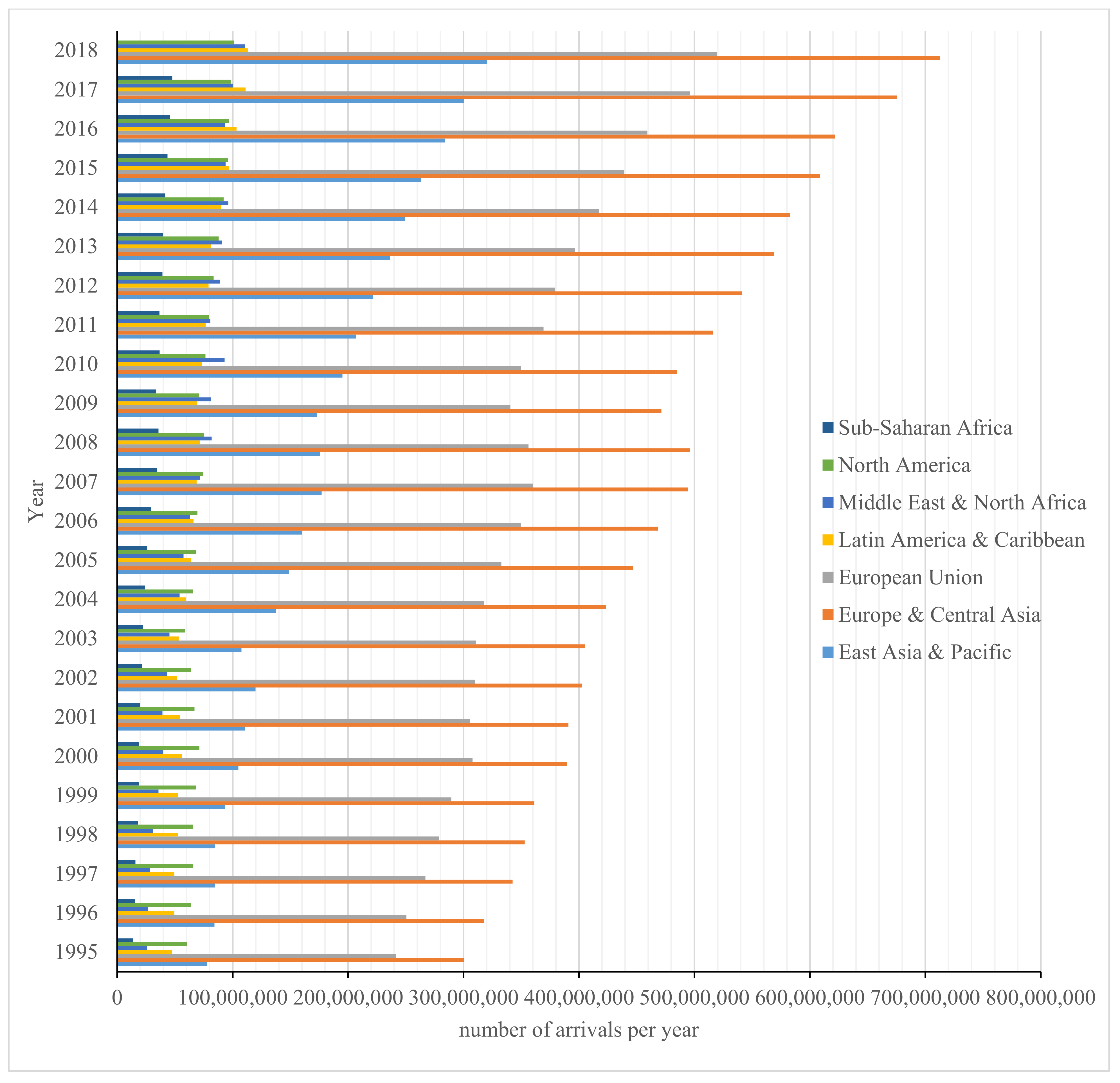
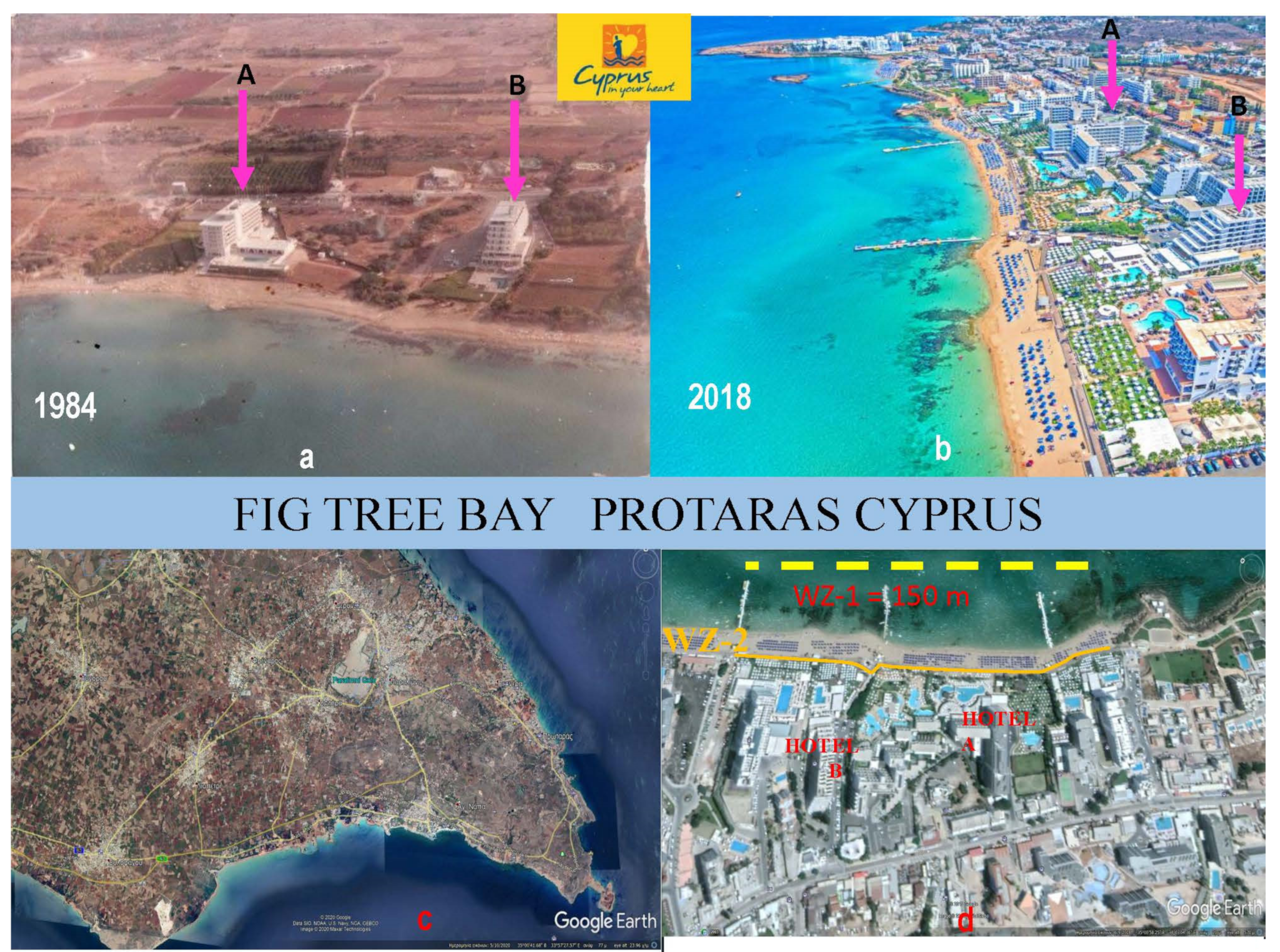

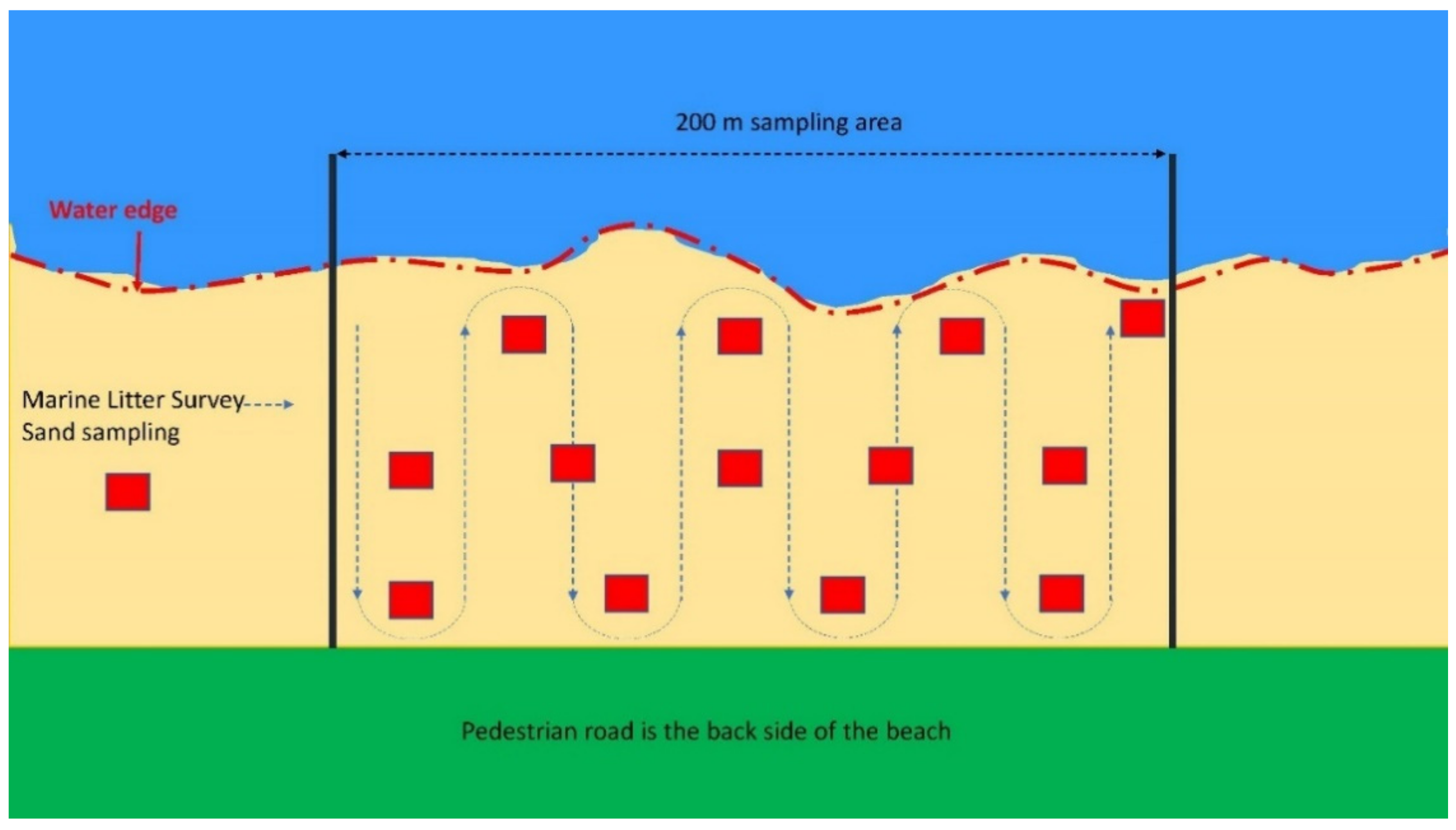
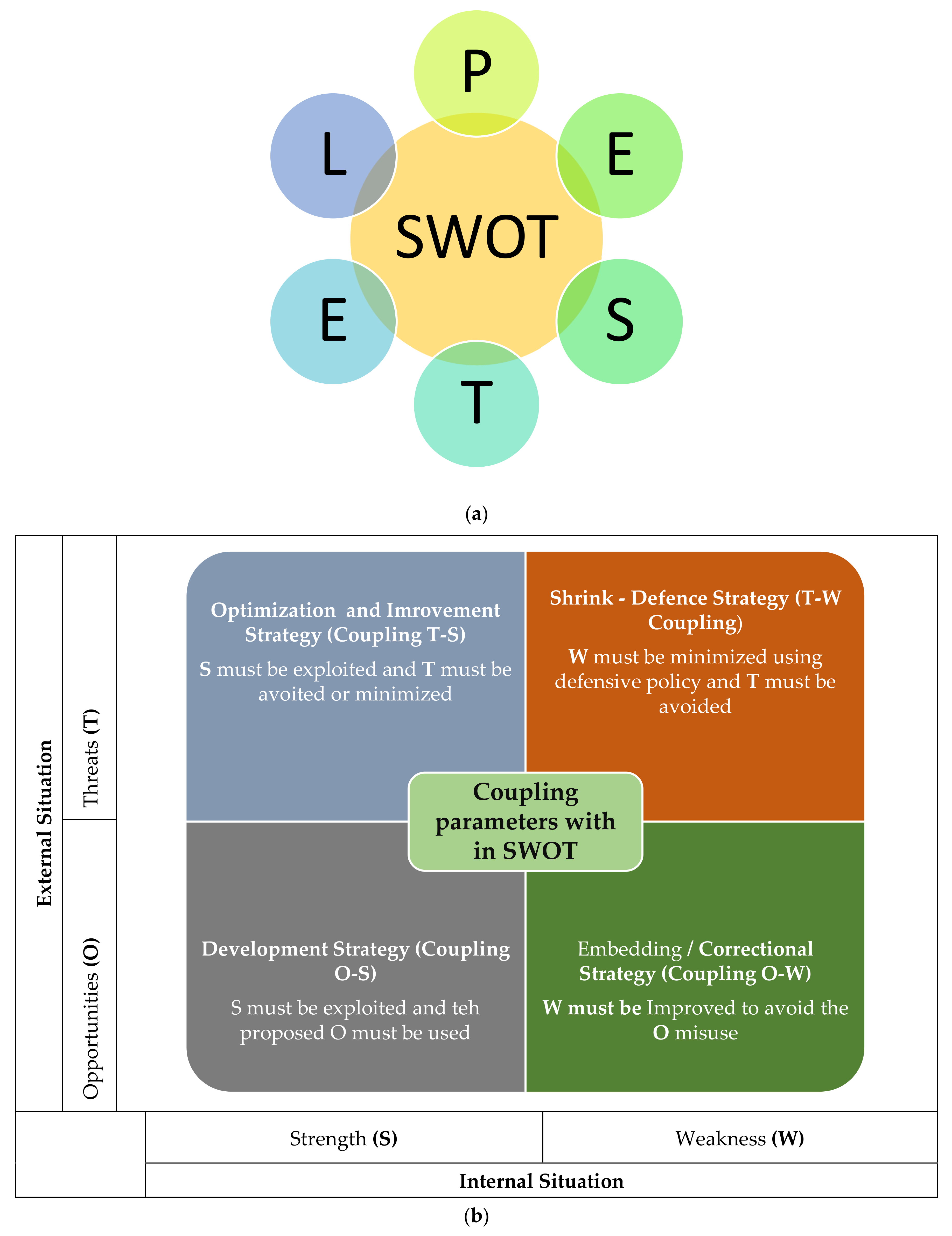

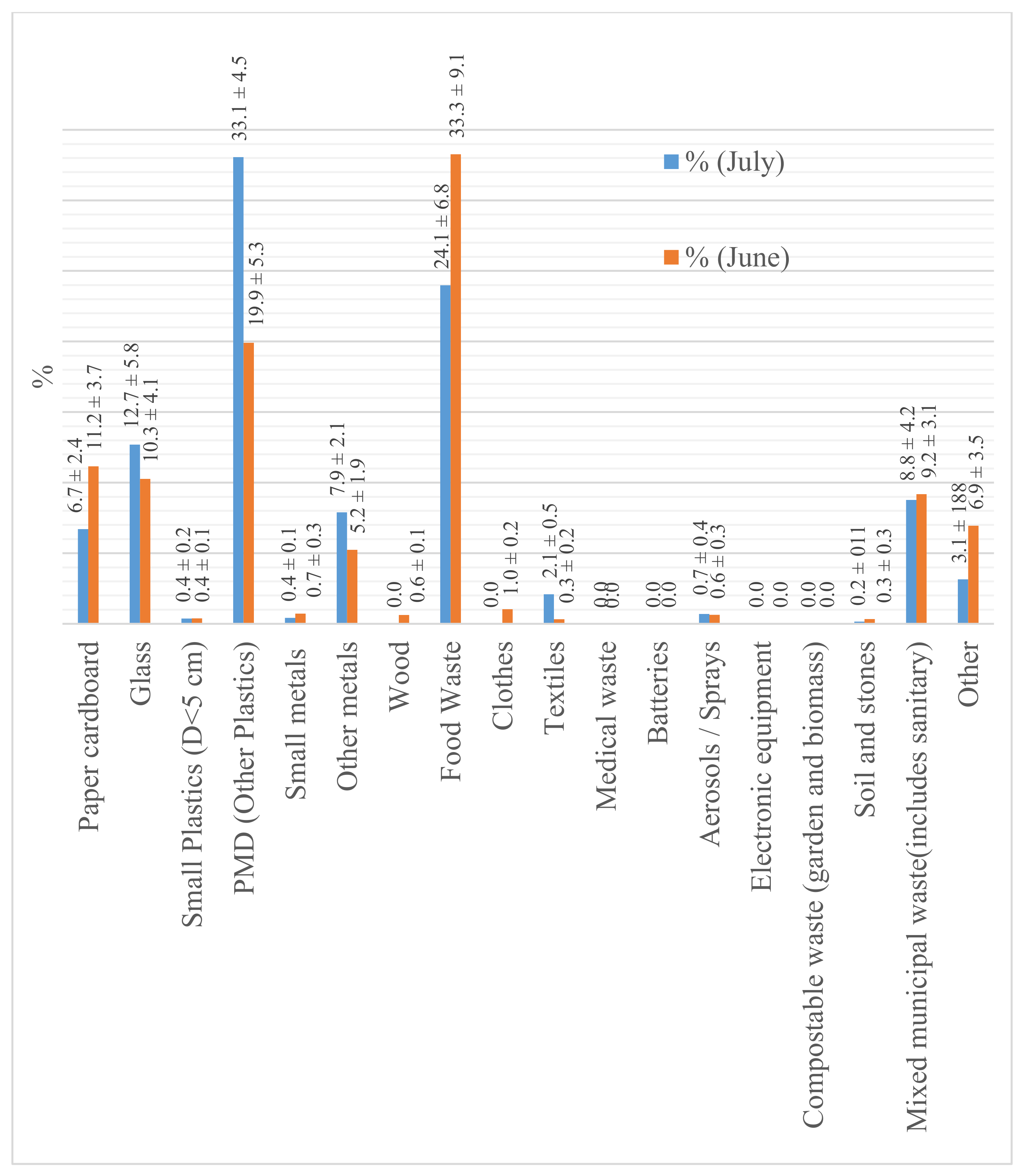

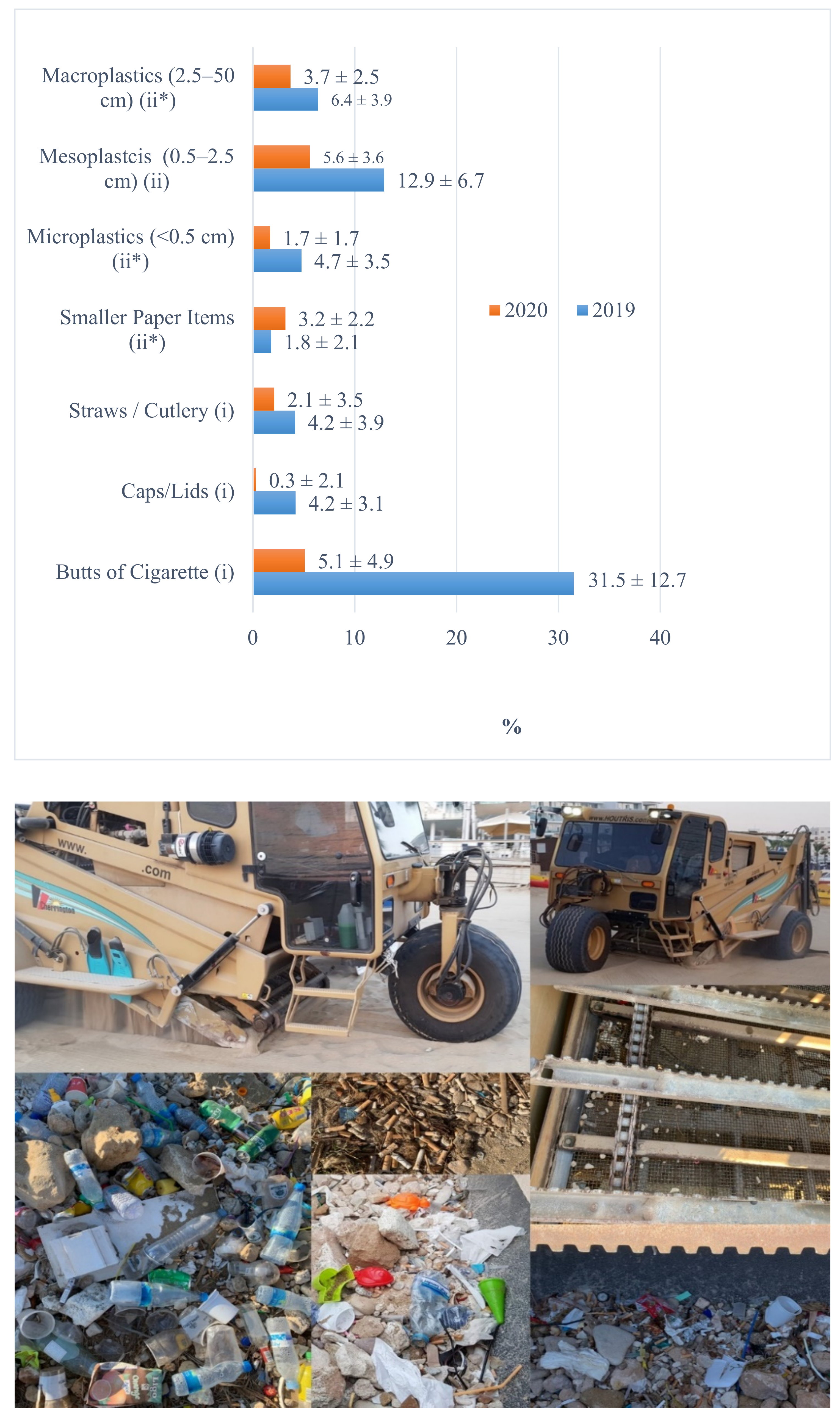
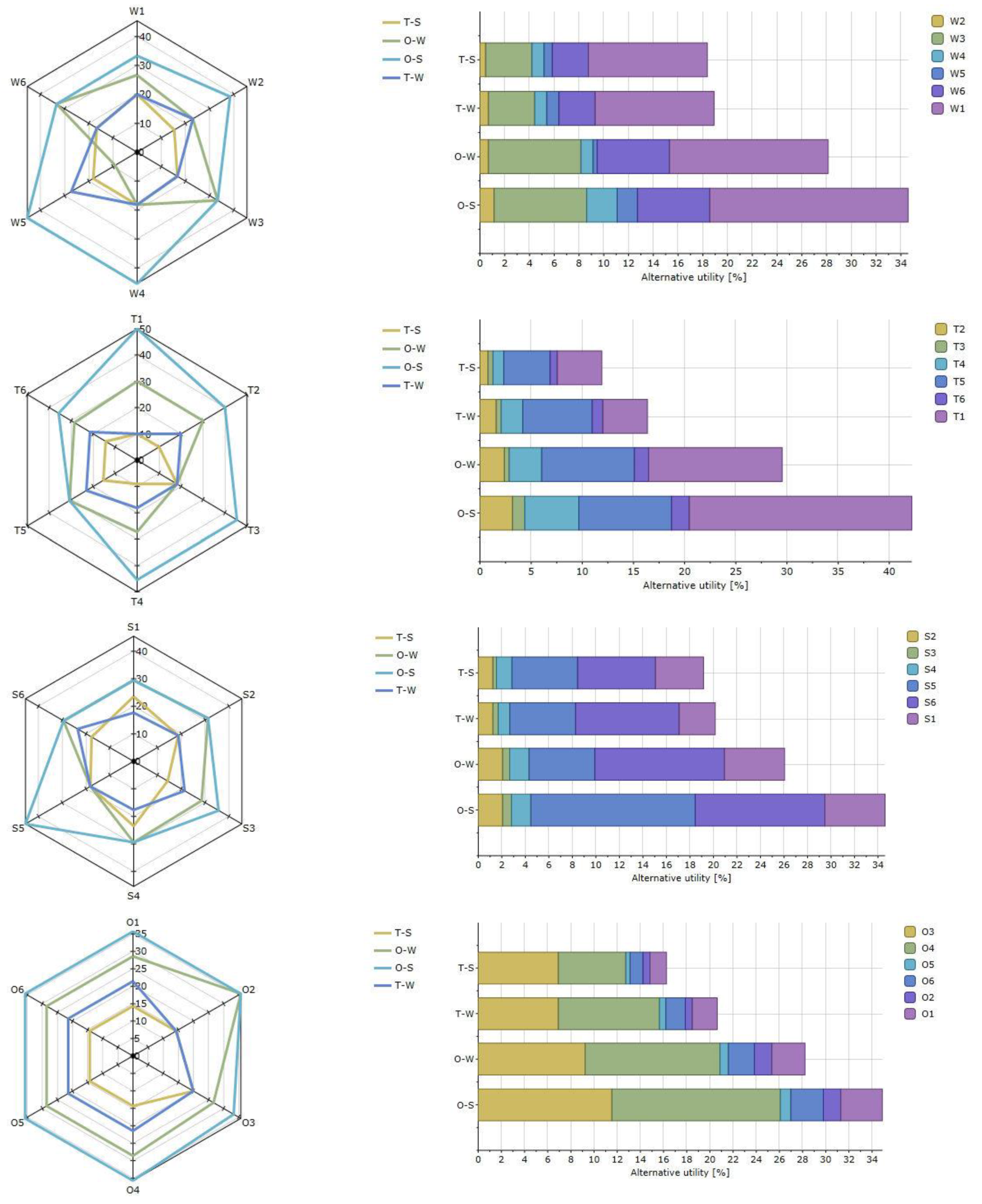
| Internal Aspects (int) | External Aspects (ext) | |||
|---|---|---|---|---|
| SWOT | S (+) | W (−) | O (+) | T (−) |
| PESTEL | ||||
| Political | Pol, int, + | Pol, int, − | Pol, ext, + | Pol, ext, − |
| Economic | Eco, int, + | Eco, int, − | Eco, ext, + | Eco, ext, − |
| Social | Soc, int, + | Soc, int, − | Soc, ext, + | Soc, ext, − |
| Technological | Tec, int, + | Tec, int, − | Tec, ext, + | Tec, ext, − |
| Legal | Leg, int, + | Leg, int, − | Leg, ext, + | Leg, ext, − |
| Environmental | Env, int, + | Env, int, − | Env, ext, + | Env, ext, − |
| 1984 * | 2019 | 2020 (during the COVID-19 Pandemic) | |
|---|---|---|---|
| CCI | <1 | 3.94 | 0.9–2.6 |
| WAI | <0.5 | 3.4–4.6 | 0.8–2.2 |
| WAR | <0.000001 | 0.1–0.001 | 0.001–0.0001 |
| LOS | 2 | 1–2 | |
| WBC | 1.33 ± 0.31 L/Guest | 1.57 ± 0.36 L/Guest | |
| WI | 0.023 ± 0.009 | 0.031 ± 0.015 | |
| RBP | 1/1600 guest | 3/1600 quest | |
| LOS | Category B to A | Category A |
| Sunday | Monday | Tuesday | Wednesday | Thursday | Friday | Saturday | |
|---|---|---|---|---|---|---|---|
| Visitors 08:00–09:00 | 734 | 615 | 671 | 467 | 635 | 703 | 699 |
| WGR WZ-1 in kg | 25.344 | 5.985 | 0 | 5.7015 | 63.702 | 27.612 | 28.404 |
| P-MSW (08:00–09:00) | 0.0345 | 0.0097 | 0.0000 | 0.0122 | 0.1003 | 0.0393 | 0.0406 |
| WBC (08:00–09:00) | 0.3427 | 0.2871 | 0.3133 | 0.2180 | 0.2965 | 0.3282 | 0.3263 |
| Visitors (13:00–14:00) | 1662 | 1547 | 1549 | 1489 | 1398 | 1527 | 1603 |
| WGR WZ-1 in kg | 71.046 | 21.177 | 0.783 | 15.471 | 41.661 | 18.882 | 63.189 |
| P-MSW (13:00–14:00) | 0.0427 | 0.0137 | 0.0005 | 0.0104 | 0.0298 | 0.0124 | 0.0394 |
| WBC (13:00–14:00) | 0.7759 | 0.7222 | 0.7232 | 0.6951 | 0.6527 | 0.7129 | 0.7484 |
| Visitors (17:00–18:00) | 1509 | 1362 | 1472 | 1237 | 1147 | 1489 | 1499 |
| WGR WZ-1 in kg | 86.454 | 11.448 | 17.874 | 26.2575 | 49.536 | 46.926 | 90.819 |
| P-MSW (17:00–18:00) | 0.0573 | 0.0084 | 0.0121 | 0.0212 | 0.0432 | 0.0315 | 0.0606 |
| WBC (17:00–18:00) | 0.7045 | 0.6359 | 0.6872 | 0.5775 | 0.5355 | 0.6951 | 0.6998 |
| Total WGR WZ-1 in kg | 182.84 ± 31.78 | 38.61 ± 7.70 | 18.65 ± 10.10 | 47.43 ± 10.28 | 154.89 ± 11.17 | 93.42 ± 14.35 | 182.41 ± 31.28 |
| P-MSW | 0.045 ± 0.012 | 0.011 ± 0.003 | 0.004 ± 0.007 | 0.015 ± 0.006 | 0.058 ± 0.037 | 0.028 ± 0.014 | 0.047 ± 0.012 |
| WBC | 0.6077 ± 0.23 | 0.5484 ± 0.23 | 0.5745 ± 0.22 | 0.4969 ± 0.24 | 0.4949 ± 0.18 | 0.5787 ± 0.21 | 0.5915 ± 0.23 |
| External Aspects | |||||||||||||||
| Opportunities | Pol | Eco | Soc | Tec | Leg | Env | Threats | Pol | Eco | Soc | Tec | Leg | Env | ||
| O1 | To improve the existing environmental performance | +2 | +4 | +5 | +3 | +5 | +5 | T1 | Lack of public policy that is concerned with environmental issues | −3 | −3 | −4 | −2 | −1 | −5 |
| O2 | To improve waste infrastructure | +1 | +4 | +5 | +3 | +3 | +5 | T2 | Non-existence of any awareness activities related to waste strategies (i.e., reduce, reuse, recycling, prevention, etc.) | −2 | −3 | −4 | −1 | −4 | −5 |
| O3 | To avoid littering in the sea (microplastics) | +3 | +5 | +4 | +3 | +5 | +5 | T3 | Massive tourist activities (and seasonality) | −3 | −5 | −5 | −1 | −1 | −5 |
| O4 | To change citizens attitude and behavior regarding waste disposal | +2 | +3 | +4 | +3 | +5 | +5 | T4 | Pandemic announcement (i.e., COVID-19) | −3 | −5 | −4 | −1 | −1 | −5 |
| O5 | To increase recycling index | +1 | +3 | +5 | +1 | +3 | +5 | T5 | Not appropriate cleaning of the beach | −2 | −5 | −4 | −2 | −1 | −5 |
| O6 | To turn the beach to a “Smart and Sustainable Destination” | +4 | +4 | +3 | +2 | +5 | +5 | T6 | Pollution at the coastal areas and degradation of the marine ecosystem | −3 | −5 | −5 | −3 | −5 | −5 |
| Internal Aspects | |||||||||||||||
| Strengths | Pol | Eco | Soc | Tec | Leg | Env | Weaknesses | Pol | Eco | Soc | Tec | Leg | Env | ||
| S1 | Reputation of the area | +5 | +5 | +5 | +2 | +1 | +5 | W1 | The absence of a holistic waste strategy | −2 | −2 | −4 | −3 | −3 | −5 |
| S2 | Organized Beach | +3 | +5 | +5 | +4 | +4 | +5 | W2 | Absence of waste management infrastructures | −2 | −4 | −5 | −1 | −1 | −5 |
| S3 | Existing hospitality industry for many years | +4 | +5 | +5 | +2 | +3 | +5 | W3 | Lack of Beach watchers (i.e., local police to monitor littering) | −2 | −3 | −4 | −1 | −2 | −5 |
| S4 | The expansion of tourism in the area and in the Country | +5 | +5 | +5 | +3 | +2 | +5 | W4 | Minimum awareness activities, advertising, and marketing | −1 | −2 | −5 | −1 | −1 | −5 |
| S5 | Strong government support behind the industry | +5 | +5 | +5 | +1 | +4 | +5 | W5 | Lack of educational programs for the citizens | −1 | −2 | −5 | −1 | −1 | −5 |
| S6 | LOS | +2 | +3 | +4 | +2 | +3 | +5 | W6 | Lack of Technical standard | −1 | −2 | −3 | −1 | −1 | −5 |
| THREATS | T.6 | x | x | x | x | x | x | x | x | x | x | x | |
| T.5 | x | x | x | x | x | x | x | x | x | ||||
| T.4 | x | x | |||||||||||
| T.3 | x | x | x | x | x | x | x | x | x | ||||
| T.2 | x | x | x | x | x | x | x | ||||||
| T.1 | x | x | x | x | x | x | x | x | x | x | x | ||
| OPPORTUNITIES | O.6 | x | x | x | x | x | x | x | x | ||||
| O.5 | x | x | x | x | x | x | x | x | x | x | |||
| O.4 | x | x | x | x | x | x | x | ||||||
| O.3 | x | x | x | x | x | x | x | x | x | x | x | x | |
| O.2 | x | x | x | x | x | x | x | ||||||
| O.1 | x | x | x | x | x | x | x | x | x | x | x | x | |
| SWOT MATRIX | S.1 | S.2 | S.3 | S.4 | S.5 | S.6 | W.1 | W.2 | W.3 | W.4 | W.5 | W.6 | |
| STRENGTHS | WEAKNESSES | ||||||||||||
Publisher’s Note: MDPI stays neutral with regard to jurisdictional claims in published maps and institutional affiliations. |
© 2021 by the authors. Licensee MDPI, Basel, Switzerland. This article is an open access article distributed under the terms and conditions of the Creative Commons Attribution (CC BY) license (http://creativecommons.org/licenses/by/4.0/).
Share and Cite
Loizia, P.; Voukkali, I.; Chatziparaskeva, G.; Navarro-Pedreño, J.; Zorpas, A.A. Measuring the Level of Environmental Performance on Coastal Environment before and during the COVID-19 Pandemic: A Case Study from Cyprus. Sustainability 2021, 13, 2485. https://doi.org/10.3390/su13052485
Loizia P, Voukkali I, Chatziparaskeva G, Navarro-Pedreño J, Zorpas AA. Measuring the Level of Environmental Performance on Coastal Environment before and during the COVID-19 Pandemic: A Case Study from Cyprus. Sustainability. 2021; 13(5):2485. https://doi.org/10.3390/su13052485
Chicago/Turabian StyleLoizia, Pantelitsa, Irene Voukkali, Georgia Chatziparaskeva, Jose Navarro-Pedreño, and Antonis A. Zorpas. 2021. "Measuring the Level of Environmental Performance on Coastal Environment before and during the COVID-19 Pandemic: A Case Study from Cyprus" Sustainability 13, no. 5: 2485. https://doi.org/10.3390/su13052485
APA StyleLoizia, P., Voukkali, I., Chatziparaskeva, G., Navarro-Pedreño, J., & Zorpas, A. A. (2021). Measuring the Level of Environmental Performance on Coastal Environment before and during the COVID-19 Pandemic: A Case Study from Cyprus. Sustainability, 13(5), 2485. https://doi.org/10.3390/su13052485









